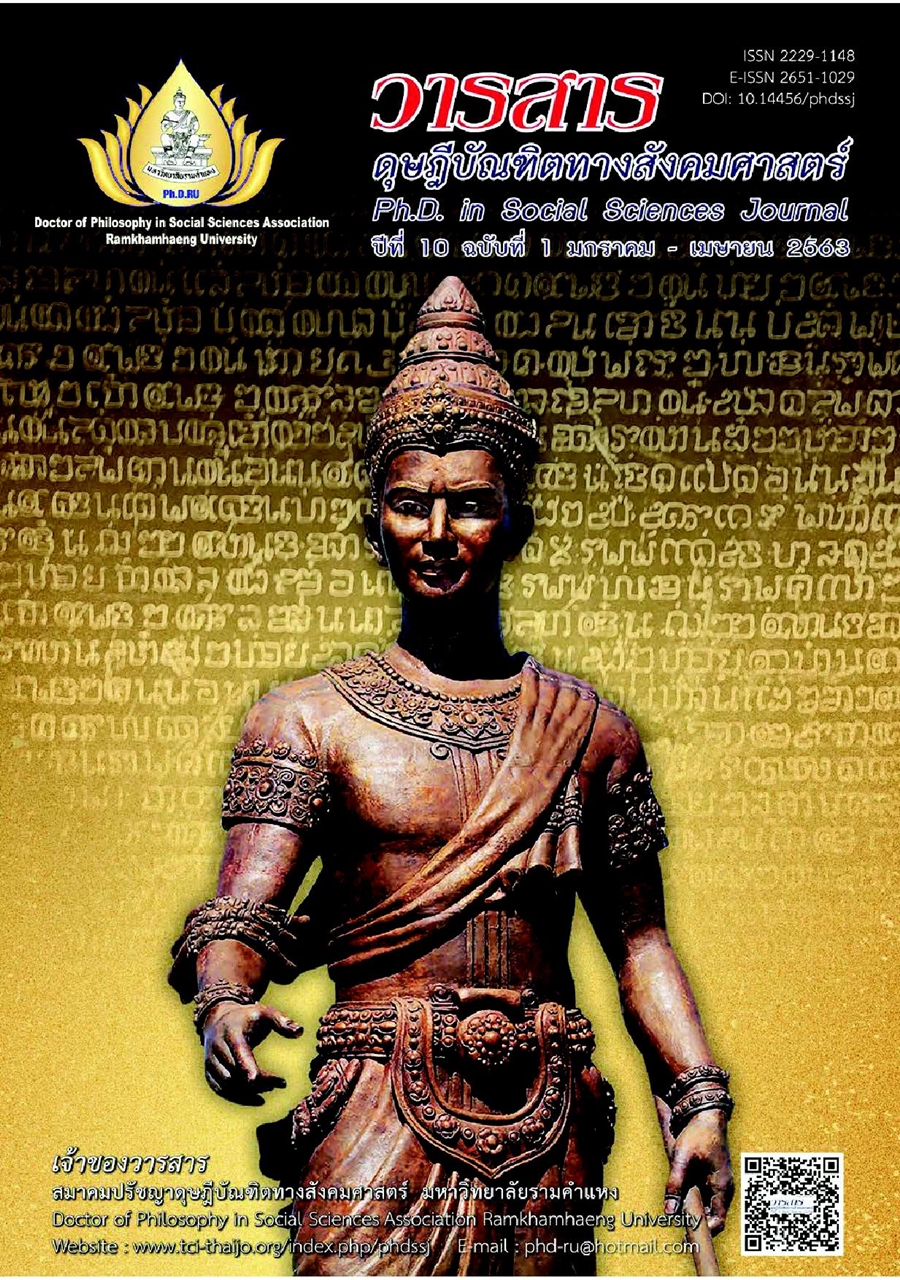การสร้างแบรนด์รีโซแนนซ์โดยอาศัยคุณค่าความสัมพันธ์ของลูกค้าและการมีส่วนร่วมสร้างจากสังคมเสมือนในบริบทของผู้ให้บริการเครือข่ายโทรศัพท์เคลื่อนที่: บริษัท เอบีซี จำกัด
Main Article Content
บทคัดย่อ
การวิจัยครั้งนี้มีวัตถุประสงค์เพื่อศึกษาถึงอิทธิพลของระดับความสัมพันธ์ของลูกค้า และความผูกพันต่อสังคมเสมือนของผู้ใช้ตราสินค้าเดียวกันซึ่งส่งผ่านคุณค่าการรับรู้ทางอารมณ์ทั้งที่เกิดจากปัจจัยภายในและภายนอก ใช้ระเบียบวิธีการวิจัยเชิงปริมาณ ดำเนินการโดยใช้แบบสอบถามสำรวจข้อมูลจากกลุ่มตัวแทนผู้ใช้บริการเครือข่าย เอบีซีซึ่งเป็นสมาชิกกลุ่มสังคมออนไลน์เอบีซี (แฟนเพจ) จำนวน 506 ตัวอย่าง
ผลการวิจัย พบว่า ค่าเฉลี่ยระดับการรับรู้ปัจจัยที่ศึกษาได้แก่คุณค่าความสัมพันธ์ คุณค่าการรับรู้ทางอารมณ์ ซึ่งเกิดจากปัจจัยภายนอกการมีส่วนร่วมสร้างจากสังคมเสมือนคุณค่าการรับรู้ทางอารมณ์ซึ่งเกิดจากปัจจัยภายใน มีค่าเท่ากับ 2.2361.9631.949 และ 1.870 ตามลำดับ
ผลการทดสอบยืนยันตัวแบบเชิงสาเหตุ พบว่า การมีส่วนร่วมสร้างจากสังคมเสมือนและคุณค่าความสัมพันธ์ของลูกค้ามีผลต่อแบรนด์รีโซแนนซ์ โดยการมีส่วนร่วมสร้างจากสังคมเสมือนส่งผลโดยตรงกับปัจจัยส่งผ่าน คือ คุณค่าการรับรู้ทางอารมณ์ซึ่งเกิดจากปัจจัยภายใน ในขณะที่คุณค่าความสัมพันธ์ของลูกค้าส่งผลโดยอ้อมจากปัจจัยส่งผ่านการมีส่วนร่วมสร้างจากสังคมเสมือน และคุณค่าการรับรู้ทางอารมณ์ซึ่งเกิดจากปัจจัยภายในตัวแปรทั้งสองทำหน้าที่ตัวแปรส่งผ่านต่อเนื่องไปสู่แบรนด์รีโซแนนซ์ในบริบทของสมาชิกสังคมเสมือนในประเทศไทย
Article Details
บทความวิชาการ บทความวิจัย และบทวิจารณ์หนังสือในวารสารดุษฎีบัณฑิตทางสังคมศาสตร์ เป็นความคิดเห็นของผู้เขียน มิใช่ของคณะผู้จัดทำ และมิใช่ความรับผิดชอบของสมาคมปรัชญาดุษฎีบัณฑิตทางสังคมศาสตร์ มหาวิทยาลัยรามคำแหง (กรณีการทำวิจัยในมนุษย์ ผู้วิจัยต้องผ่านการอบรมจริยธรรมการวิจัยในมนุษย์ และนำหลักฐานมาแสดง)
เอกสารอ้างอิง
Arslanagic-Kalajdzic, M., & Zabkar, V. (2017). Is perceived value more than value for money in professional business service. Journal of Industrial Marketing Management, 65, 47-58.
Barrera M. (1986). Distinction between social support concepts, measures and models. American Journal of Community. Psychology, 14(4), 413-445.
Brack, A. D., & Benkenstein, M. (2012). The effects of overall similarity regarding the customerto-customer-relationship in a service context. Journal of Retailing and Consumer Services, 19(5), 501-509.
Cropansano R., & Floger, R. (1989) Referent cognitions and task decision autonomy: Beyond equity theory. Journal of Apply Psychology, 74(2), 293-299.
Chen, C. F., & Wang, P. (2016). Customer participation, value co-creation and customer loyalty: A case of airline online check-in system. Computers in Human Behavior, 62, 346-352.
Doyle, P. (2008). Value based marketing: Marketing strategies for corporate growth and shareholder value. John Wiley & Sons.
Emerson, R. (1976). Social exchange theory. Annual Review of Sociology, 2(1), 335-362.
Government Savings Bank. GSB Research. (2017). Communication business. Retrieved from https://www.gsb.or.th/getattachment/651747b3-f9fc-4924-89da-34383c53f942/Info [In Thai]
Hatchfield, E., & Traupmann, J. (1977). Intimate relationship: A perspective from equity theory. University of Wisconcil.
Hsieh, S. H., & Chang, A. (2016). The psychological mechanism of brand co-creation engagement. Journal of Interactive Marketing, 33(13), 13-26.
Keller, K. L. (1993). Conceptualizing measuring and managing customer-based brand equity. Journal of Marketing, 57(1), 1-22.
Keller, K. L. (2001). Building customer-based brand equity: A blueprint for creating strong brand. Cambridge, Marketing Science Institute.
Keller, K. L. (2013). Strategic brand management building, measuring, and managing brand equity (4th ed.). Pearson Education.
Marketing Oops. (2017). Mobile Phone. Retrieved from https://www.yozzo.com/news-andinformation/mvno-mobile-operator-s/mobile-market-shares-thailand-2016 [In Thai]
Occhiocupo, N., & Friess, M. (2013). Exploring what motivates consumers to co-create value in virtual fashion communities (p. 2-16). In Naples Forum on Service [Online] Retrieved from https://www.naplesforumonservice.it/uploads/files/Occhiocupo,%20Friess.pdf
Prachachat Online. (2017). 2016 High competitionin Thai Mobilephone Industry. Retrieved from https://www.prachachat.net/news_detail.php?newsid=1483332258 [In Thai]
Ulaga, W., & Eggert, A. (2006). Value-based differentiation in business relationships: Gaining and sustaining key supplier status. Journal of Marketing, 70(1), 119-136.
Westland, J. C. (2010). Lower bounds on sample size in structural equation modeling. Electronic Commerce Research and Applications, 9(6), 476-487.
Zeithaml, V. A., Parasuraman, A., & Berry, L. L. (1985). Problems and strategies in services marketing. Journal of Marketing, 49(4), 33-46.
Zhang R., & Nuan L, (2016). Understanding relationship benefits from harmonious brand community on social media. Internet Research, 26(4), 809-826.
Zhu, W., Wang, C. D., & Chong, C. C. (2016). Adult attachment, perceived social support, cultural orientation, and depressive symptoms: A moderated mediation model. Journal of Counseling Psychology, 63(6), 645-655.


